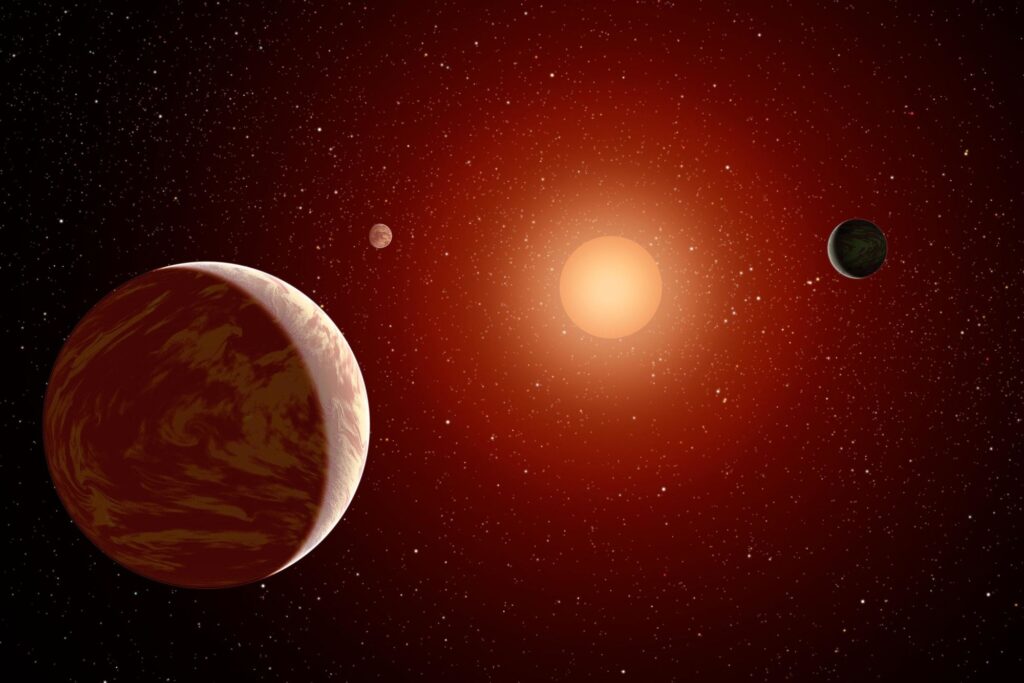
For all the speculation about life beyond Earth, our planet remains the only confirmed example of a life-bearing world. This singularity in the cosmic context makes Earth’s place in the universe both ordinary and extraordinary. Two facts add complexity to this puzzle: we exist in the first 0.1% of the era when stars shine, and our planet orbits a Sun-like star, even though most stars are smaller, dimmer red dwarfs.
Astronomer David Kipping from Columbia University believes these facts should influence how we assess the odds of life elsewhere. In his new analysis, titled “Solar Hegemony: M-Dwarfs Are Unlikely to Host Observers Such as Ourselves” (2025), Kipping questions whether our presence around a G-type star is mere luck or a significant clue. His findings strongly suggest the latter.
Using Bayesian modeling, Kipping concludes that the probability of our situation being a coincidence is exceptionally low. The Bayes factor stands at about 1,600 to 1 against the “luck” hypothesis, a figure that far exceeds the threshold for “decisive evidence.”
Reframing Habitability: Two Key Hypotheses
Kipping introduces two hypotheses to explain our cosmic circumstances. The first, the Desolate M-dwarf Hypothesis, posits that stars below a critical mass, Mcrit, do not support observers—beings capable of contemplation and measurement. The second, the Truncated Window Hypothesis, suggests that planets have a limited time span, Twin, during which observers can emerge, shorter than the star’s total lifespan.
These hypotheses address different constraints. Smaller stars might be inhospitable to complex life, while planets could lose their life-supporting characteristics before their stars extinguish. Kipping’s model tests these ideas against the undeniable fact that observers exist now, around a Sun-like star, 13.8 billion years after the Big Bang.
Modeling Cosmic Odds
To evaluate these scenarios, Kipping simulates the formation of one million stars throughout the universe’s history. Each star receives a birth date based on realistic formation rates and a mass from a standard distribution. The simulation then projects forward in time to determine which systems could host observers at any given moment.
Three criteria must be met for a system to potentially host observers: sufficient time must have passed since a star’s birth to allow for complex life, modeled as a universal three-billion-year delay; the planetary “observer window” must still be open; and the star’s mass must exceed Mcrit, the threshold for potentially life-bearing systems.
The results indicate a significant mass cutoff, with models favoring a lower limit of Mcrit greater than about 0.45 solar masses at 2σ confidence. This would exclude approximately three-quarters of all stars, primarily red dwarfs, from hosting observers.
Why Red Dwarfs May Fall Short
Despite their abundance and frequent hosting of rocky worlds in temperate orbits, red dwarfs might not be the best candidates for life. They often emit flares that expose planets to ultraviolet radiation, potentially eroding atmospheres on closely orbiting worlds. Their extreme longevity could also inhibit the geologic processes necessary for recycling nutrients and stabilizing climates.
Recent telescope observations support these concerns. Studies of TRAPPIST-1, a red dwarf with seven Earth-sized planets, suggest that at least three lack detectable atmospheres, complicating the potential for surface life. Although Kipping’s argument does not rely on these mechanisms, the independent evidence aligns with his findings.
The Copernican Principle Revisited
The Copernican principle cautions against assuming a special position in the universe, a concept that has shaped modern astronomy and cultural perceptions of our typicality. Carl Sagan famously warned, “But absence of evidence is not evidence of absence.” Optimists highlight the vast number of stars and the billions of years of cosmic time, suggesting that intelligent neighbors are likely.
Kipping, however, emphasizes the Sun’s distinctiveness. G-type stars are a minority, and our solar system is uniquely quiet and singular, with giant planets situated far from the Sun. These characteristics may be significant. “My paper looks at two puzzles that are undeniably unusual,” Kipping explained. “Some 80% of stars are M-dwarfs… yet we do not live around one… Second, the stelliferous period of the Universe extends until 10,000 Gyr from now, yet here we are living in the first 0.1% of that window.”
“My paper finds the odds of this being the case to be 1600:1 against,” Kipping stated regarding the luck explanation. “In science, we usually say anything above 10:1 is strong evidence and 100:1 is ‘decisive,’ so 1600:1 is truly enormous odds for a luck-proponent to sit comfortably with.”
Practical Implications for the Search for Life
This analysis suggests a strategic shift in the search for life. Surveys and SETI projects should focus less on red dwarfs and more on stars with masses between roughly 0.74 and 1.6 solar masses, which include the Sun and slightly larger, brighter stars. While red dwarfs should not be entirely discounted, as advanced civilizations might migrate or adapt, the most promising targets resemble our own solar system.
Kipping’s work at Columbia’s Cool Worlds Laboratory explores extrasolar systems and methods to detect technosignatures. He highlights the potential of upcoming telescopes to image Earth-like planets around Sun-like stars. The proposed Habitable Worlds Observatory, slated for the mid-2040s, is a step in this direction.
Bayesian analysis does not provide absolute truths but rather indicates how evidence should influence beliefs. These shifts depend on initial assumptions. If one assumes equal likelihood for all stars to host observers, a Sun-centric outcome may be resisted. Kipping advocates for humility, allowing data to guide conclusions. In this instance, the data suggests a significant shift in focus.
Sagan’s broader point remains valid. While there is no definitive proof that red dwarfs cannot support life, there is strong evidence that observers like us are less likely to be found there. This evidence should guide future explorations.
Research findings are available online in the journal arXiv.







